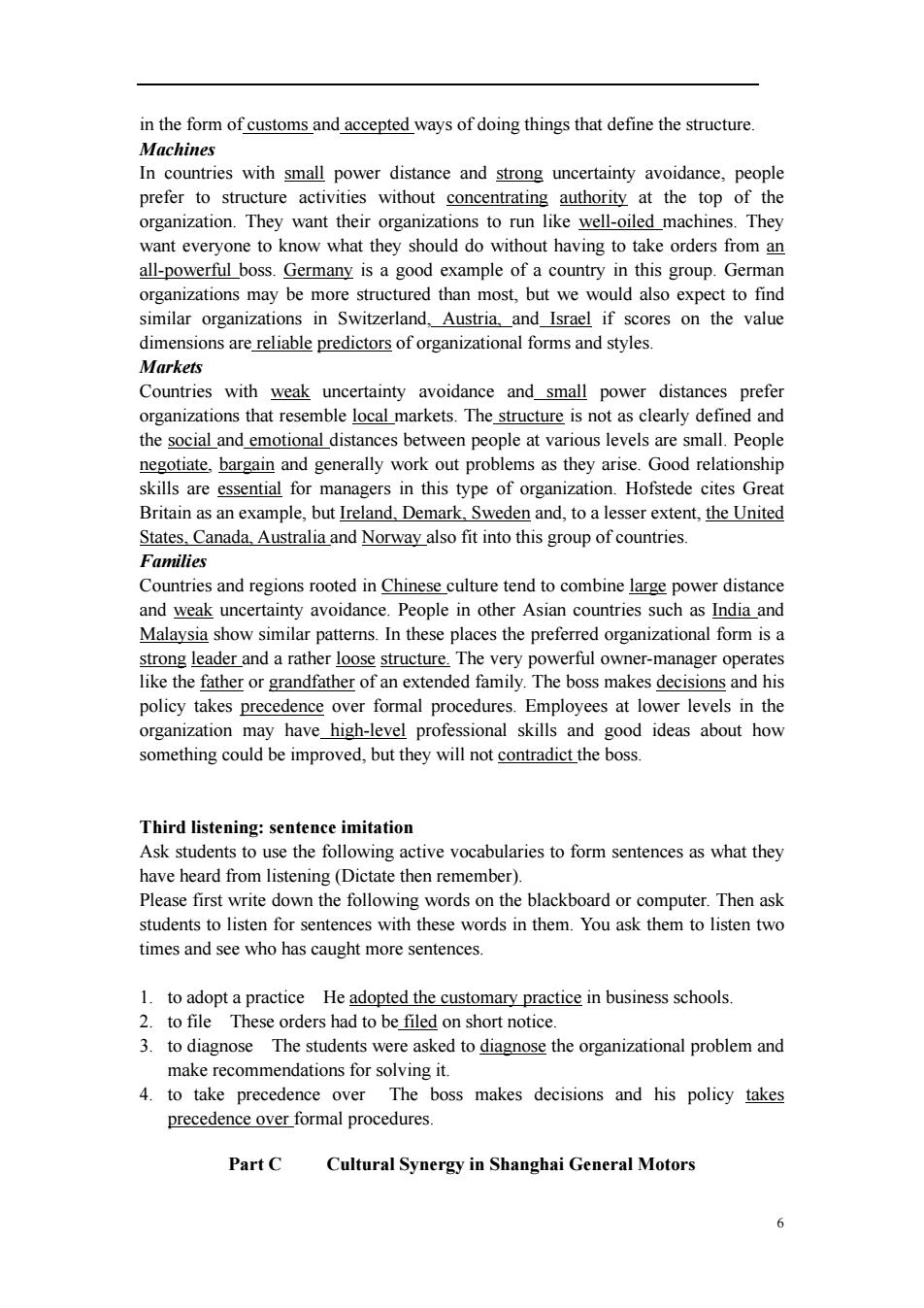正在加载图片...

in the form of customs and accepted ways of doing things that define the structure. Machines In countries with small power distance and strong uncertainty avoidance,people prefer to structure activities without concentrating authority at the top of the organization.They want their organizations to run like well-oiled machines.They want everyone to know what they should do without having to take orders from an all-powerful boss.Germany is a good example of a country in this group.German organizations may be more structured than most,but we would also expect to find similar organizations in Switzerland,Austria,and Israel if scores on the value dimensions are reliable predictors of organizational forms and styles. Markets Countries with weak uncertainty avoidance and small power distances prefer organizations that resemble local markets.The structure is not as clearly defined and the social and emotional distances between people at various levels are small.People negotiate,bargain and generally work out problems as they arise.Good relationship skills are essential for managers in this type of organization.Hofstede cites Great Britain as an example,but Ireland,Demark,Sweden and,to a lesser extent,the United States,Canada,Australia and Norway also fit into this group of countries. Families Countries and regions rooted in Chinese culture tend to combine large power distance and weak uncertainty avoidance.People in other Asian countries such as India and Malaysia show similar patterns.In these places the preferred organizational form is a strong leader and a rather loose structure.The very powerful owner-manager operates like the father or grandfather of an extended family.The boss makes decisions and his policy takes precedence over formal procedures.Employees at lower levels in the organization may have_high-level professional skills and good ideas about how something could be improved,but they will not contradict the boss. Third listening:sentence imitation Ask students to use the following active vocabularies to form sentences as what they have heard from listening(Dictate then remember). Please first write down the following words on the blackboard or computer.Then ask students to listen for sentences with these words in them.You ask them to listen two times and see who has caught more sentences. 1.to adopt a practice He adopted the customary practice in business schools 2.to file These orders had to be filed on short notice. 3.to diagnose The students were asked to diagnose the organizational problem and make recommendations for solving it. 4.to take precedence over The boss makes decisions and his policy takes precedence over formal procedures. Part C Cultural Synergy in Shanghai General Motors 6in the form of customs and accepted ways of doing things that define the structure. Machines In countries with small power distance and strong uncertainty avoidance, people prefer to structure activities without concentrating authority at the top of the organization. They want their organizations to run like well-oiled machines. They want everyone to know what they should do without having to take orders from an all-powerful boss. Germany is a good example of a country in this group. German organizations may be more structured than most, but we would also expect to find similar organizations in Switzerland, Austria, and Israel if scores on the value dimensions are reliable predictors of organizational forms and styles. Markets Countries with weak uncertainty avoidance and small power distances prefer organizations that resemble local markets. The structure is not as clearly defined and the social and emotional distances between people at various levels are small. People negotiate, bargain and generally work out problems as they arise. Good relationship skills are essential for managers in this type of organization. Hofstede cites Great Britain as an example, but Ireland, Demark, Sweden and, to a lesser extent, the United States, Canada, Australia and Norway also fit into this group of countries. Families Countries and regions rooted in Chinese culture tend to combine large power distance and weak uncertainty avoidance. People in other Asian countries such as India and Malaysia show similar patterns. In these places the preferred organizational form is a strong leader and a rather loose structure. The very powerful owner-manager operates like the father or grandfather of an extended family. The boss makes decisions and his policy takes precedence over formal procedures. Employees at lower levels in the organization may have high-level professional skills and good ideas about how something could be improved, but they will not contradict the boss. Third listening: sentence imitation Ask students to use the following active vocabularies to form sentences as what they have heard from listening (Dictate then remember). Please first write down the following words on the blackboard or computer. Then ask students to listen for sentences with these words in them. You ask them to listen two times and see who has caught more sentences. 1. to adopt a practice He adopted the customary practice in business schools. 2. to file These orders had to be filed on short notice. 3. to diagnose The students were asked to diagnose the organizational problem and make recommendations for solving it. 4. to take precedence over The boss makes decisions and his policy takes precedence over formal procedures. Part C Cultural Synergy in Shanghai General Motors 6